
Background information
Patrick Mayer: Entrepreneur in a wheelchair instead of snowboard pro
by Patrick Bardelli

The leg press of the future is already here. Meet the «ddrobotec», made by Dynamic Devices AG and developed in Zurich and Japan. I was lucky enough to be able to try it out and see where strength training is headed.
Never skip leg day. That’s one of the many golden rules of strength training. But who likes sitting at the leg press and pushing an umpteen tonne weight while your face is contorted with pain? The good news is this workout is set to become more fun, injury-free and efficient thanks to artificial intelligence (AI).
Dynamic Devices AG first developed sports products ten years ago. Their machines have already made World Cup-worthy quadriceps and hamstrings for members of the Swiss skiing team. Very few can race down the Lauberhorn in Wengen or the Streif in Kitzbühel. But since we live in a world with gravity, we’re reliant on powerful muscles. Add to this the fact we need strength as we get older if we want to still be able to get up off the toilet unaided at the age of 85.
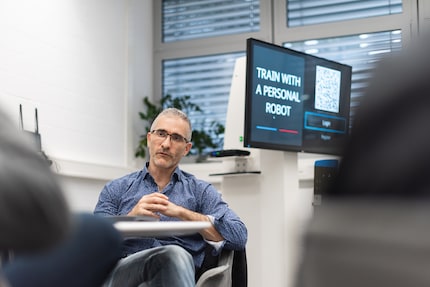
«How do we get people into strength training if they don’t care about it or haven’t given it a second thought?» That’s what Max Lungarella and his team looked into in 2014. «Our aim was to develop a system that delivers fun and easy strength training that’s high quality.» The concept for the leg press was subsequently created in collaboration with the science and technology university ETH Zurich, amongst other partners. Max cracks a smile and continues: «We’ve practically got the brain of ETH sports physiologist Marco Toigo in our leg press. He’s the one who helped us develop the device.»
The core of the leg press is made up of two artificial muscles. These are drive elements that contract with air pressure. They behave like real muscles; the artificial bit is just in regulating the system. «This is a complex process. It took us ten years to perfect these soft robotic elements,» Max explains.
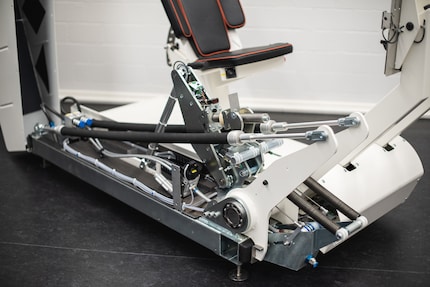
The leg press comes with software that’s easy to control via an app. It also lets you personalise training plans. I argue that this is standard stuff nowadays and every second-rate gym uses personalised training as a marketing tool. To which Max takes a deep breath and answers: «Let’s say you have a nerve disease. Neuropathy, for instance. Then you’d probably go to see a neuro-physiotherapist. While they do know a lot about the disease, they usually aren’t well-versed in strength training. Ideally, they’d have the combined knowledge of a sports scientist and a doctor. These kinds of therapists are few and far between. That’s where our system comes in. To give you an idea of some of the things we work on, we develop tailor-made training plans for patients with neurological conditions to help them learn to walk again.»
He then gives me another specific example from a different area: «We got a request from a Swiss physiotherapist who wanted to offer a special type of muscle therapy using our leg presses to the over 75s. We store the relevant information in our high-capacity plan in the cloud and give all our clients around the world access to it. That means that when a physiotherapist in Japan wants to work with our device, they don’t need to do lots of research to see how they should treat an 80-year-old patient. They’ve already got a treatment plan at their fingertips that has been validated by a Swiss hospital. This is what you call a 21st century workout. In my opinion, we’re going down the road of democratising knowledge and information.»
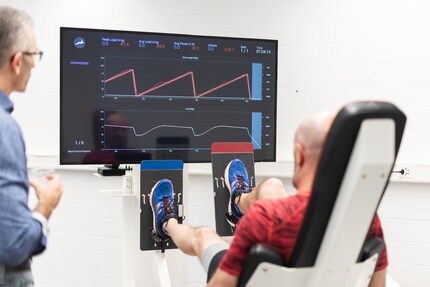
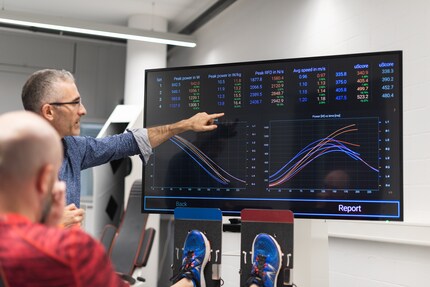
Strength training can be helpful for a variety of different groups, be it top sportspeople, those who want to age well or older people and patients with neurological conditions. But enough of the background information. It’s time I leapt onto one of these futuristic machines and put it to the test.
I start by doing various workouts with my right leg, left leg and then both legs. These exercises include having to break through resistance, work against resistance or maintain resistance. As a result, my leg muscles work in a concentrated, off-centre but equal way. This might sound similar to your eGym from your own workouts. You steer the point to the top, to the bottom or you hold it in the middle. I used to do the same thing. I’d scamper from one machine to the next so that by the end of the workout I had no idea if it had been effective or not.
With the leg press, it’s completely different. For starters, with the information from the machine, Max could tell me within just a few minutes that I should get my left knee checked out because it’s not working properly. On one of the exercises, my right leg manages around 1,500 watt, while the left has had enough after 1,200 watt. The blue and red curves (representing the left and right leg respectively) should run parallel. But they don’t on my tests. Rather than just having widespread pain in my knee for the last few weeks, I now finally have the blue chart as proof that something isn’t quite right. Hey doc, can you keep me an appointment? I’ll be right over.
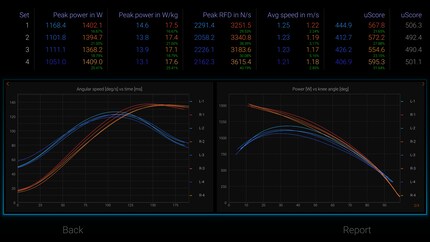
Apart from that, everything seems to be in working order. Max seems to be satisfied with the results, at least. And at the end he lets me collect silver bullets in game mode and carve out the slope as a penguin. After about half an hour, I’ve finished the training programme, leap off the leg press and have to sit down. It might be fun but it’s still exhausting.
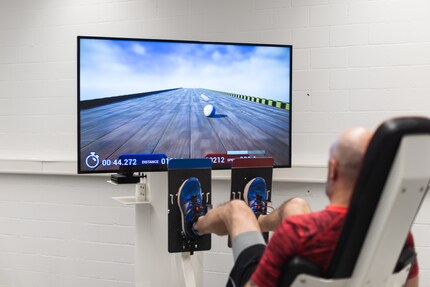
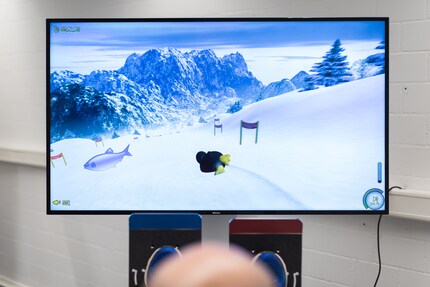
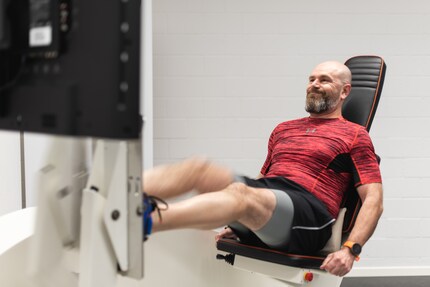
Dynamic Devices produce two models in the «ddrobotec» series. The smaller «Pro» version has been designed for medical practices, e-sports athletes, older people and children. According to Max, it’ll set you back around 70,000 Swiss francs. The larger «Elite» model that I used has a price tag of about 90,000 francs. This version has been made for neuro-athletic conditioning, performance enhancement, interactive diagnostics and training programmes for those in elite sport. Dynamic Devices clients include Redbull companies, the Japanese skiing association, and if he could easily get his hands on 90,000 francs, Patrick Bardelli as well.
If you liked this article, you’ll like these too. They’re free – no exchanges of 90,000 francs necessary. To make sure you never miss an article, go to my profile and click on «Follow author» while concentrating on your left leg.
From radio journalist to product tester and storyteller, jogger to gravel bike novice and fitness enthusiast with barbells and dumbbells. I'm excited to see where the journey'll take me next.
Interesting facts about products, behind-the-scenes looks at manufacturers and deep-dives on interesting people.
Show all